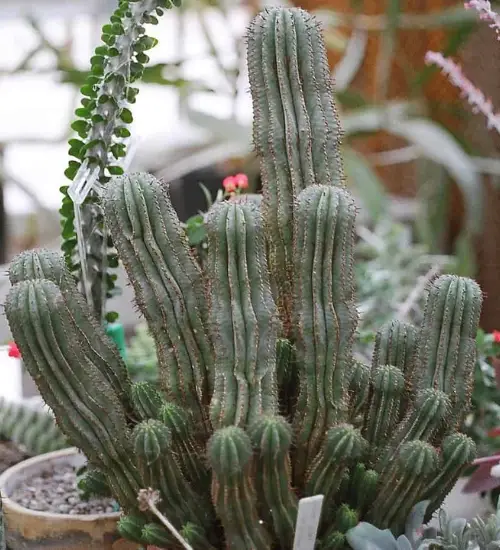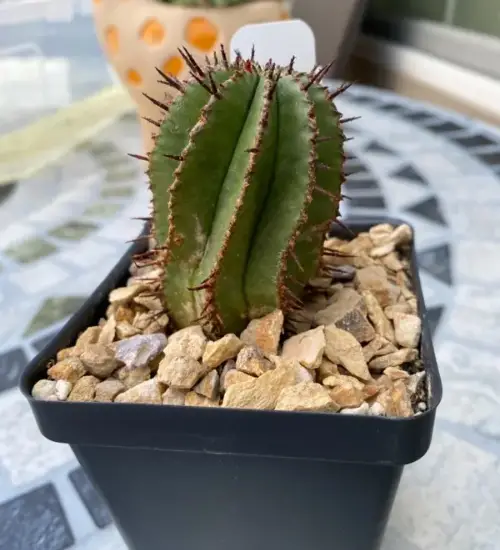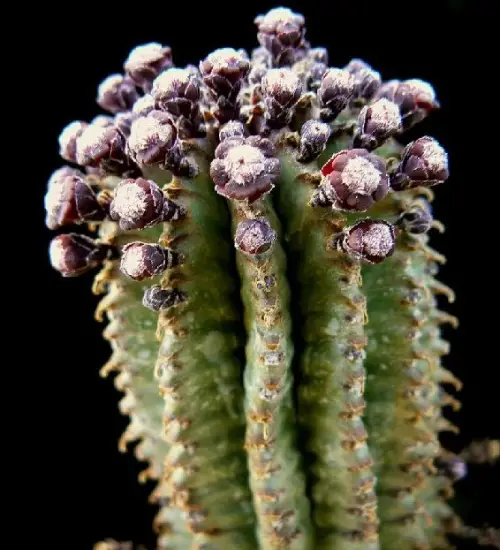Sun: full sun to partial shade
Water: Typical water needs for a succulent
Temperature: Zone 12a from 50° F to 55° F (10° C to 12.8° C)
Winter Survival: Not cold hardy
Propagation: offsets
Flower: in late winter or early spring
Flower Type:
Toxic: Can be toxic to humans and animals
Dormant: winter
Space Requirement: Indoors
Common Problems: Plants may rot if overwatered, pests
Where to buy Euphorbia cereiformis?
Basc Care for Euphorbia cereiformis
Watering
Watering for Euphorbia cereiformis is a simple task. It requires Typical water needs for a succulent.
One simple tip for you is that you can use some online apps to check the soil status before you go water your succulents. I would recommend the ThePlantsCheck app, it has some nice features there.
Fertilizing
Only feed this succulent during its active growing seasons which means spring and fall. Use the right fertilizer applied in the right amounts. Applying half-strength balanced fertilizer every month or so is recommended for optimal results.
Do not fertilize during winter as the plant is dormant.
Sun & Location Requirements for "Milk Barrel Cactus"
Euphorbia cereiformis requires full sun to partial shade. It's best to keep it in an area of your garden or home that gets plenty of bright, indirect sunlight throughout the day. When temperatures are too hot and direct sunlight is too intense, try moving "Milk Barrel Cactus" to a shadier spot for part of the day.
Euphorbia cereiformis requires full sun to partial shade in order to stay healthy and vibrant. Always keep an eye on the temperatures and light levels as too much direct sunlight can be damaging to this type of succulent. If you notice any signs of distress, try moving it to a shadier spot within your garden or home.
In order to ensure that Euphorbia cereiformis survives the winter, insulation and drainage are essential. A layer of mulch or gravel around the plant can help keep the roots warm during cold temperatures. Furthermore, avoiding exposure to wind and sun can reduce the risk of frost damage and promote longevity for your succulent.
Any succulents in the group will only need minimal space to grow. You can place your pot at your table or window. Outdoors is also a nice idea to put your pot.
Euphorbia cereiformis also benefits from some indirect light throughout the day as well, so make sure you give it enough space to soak up light without becoming too exposed to heat.
Propagation
One way to propagate Euphorbia cereiformis is by offsets. Taking an offset from the mother plant and potting it into soil will give you a brand new succulent with minimal effort.
Toxicity

The toxicity of Euphorbia can vary depending on the individual species, but all species are potentially dangerous if ingested. Symptoms of poisoning may include vomiting, abdominal pain, diarrhea and dizziness. If you believe someone has ingested parts of Euphorbia cereiformis, seek medical help immediately.
Pests and Diseases
Euphorbia cereiformis can be affected common pests and diseases like most of the other succulents such as mealybugs and scale insects.
If you do spot any of pest signs, you can treat your succulent using below methods.
- Mealybugs: quarantine, clean infected plants, soapy water.
- Scale insects: quarantine, clean infected plants, soapy water.
Besides that, to prevent serious health issues from happening, keep your succulent in a well-ventilated area and check it regularly for any signs of pests or health problems.


